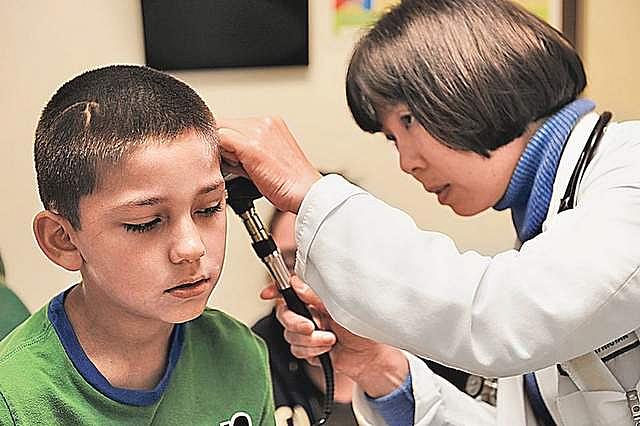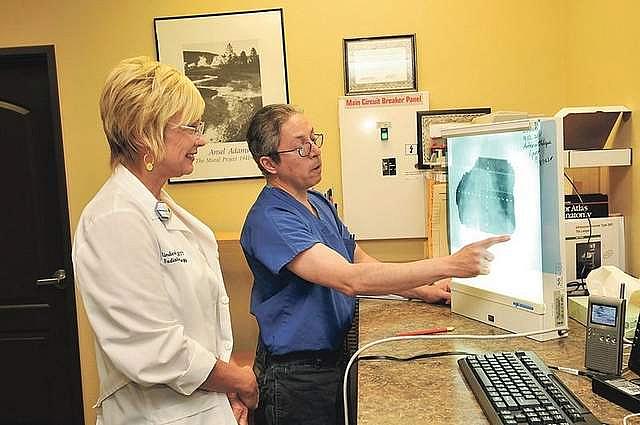Tulare County ranks 44th in doctor-to-population ratio
A look into why Tulare County, a poor, semi-rural county in California's Central Valley, has a severe lack of physicians.


Editor's note: This article was produced as a project for The California Endowment Health Journalism Fellowships, a program of the Annenberg School for Communication & Journalism at the University of Southern California.
Whether it's the dirty air, extreme summer heat or too few luxury shops and cultural events, physicians don't seem drawn to live in Tulare County.
With one doctor to serve every 925 people, Tulare County ranks 44th out of 58 counties in California for access to physicians. There are 484 physicians for 447,814 residents.
In comparison, Napa County, fifth on the list, has 464 doctors for 138,917 residents — one doctor for every 299 residents.
Not only is Tulare County at the bottom of the list for physician-to-resident ratios, it has one of the largest populations among counties at the bottom of that list. The 14 counties ranked lower than Tulare County have fewer than 259,000 residents, and 11 of those have fewer than 100,000 residents.
Lack of physicians means the local population is less likely to seek preventative care, which means medical problems will exacerbate to the point where treatment will cost more for either the individual or taxpayers, said Lindsay Mann, CEO of Kaweah Delta Health Care District.
An emergency room visit can cost three times more than a doctor's visit, and emergency rooms must give care to anyone, regardless of means to pay.
"We need patients to have access to primary care and specialists in places other than the emergency department," Mann said.
Considering that 35 percent of the county's population is on MediCal and many others are completely uninsured, the burden usually falls to taxpayers.
It becomes a cycle of medical treatment that comes after people get sick, instead of preventing the problems in the first place. This causes the overall population to be less healthy, Mann said. In fact, Tulare County is sixth highest in the state with overweight people and seventh for people diagnosed with diabetes. Both conditions can be helped by preventative health care.
Physician recruitment
It's not that local health care facilities don't try to draw physicians to Visalia, Tulare and surrounding areas. Kaweah Delta spent $63,000 in 2010 to bring physicians to the area, and $79,000 a year on a physician recruiter salary. It also offers a loan to a physician, called a Physician Recruitment Agreement, that requires them to stay in the community for two years for the loan to be forgiven, said Laura Florez, Kaweah Delta spokeswoman. The loan amount varies depending on market value and per specialty, she said, but can range from Ôªø$150,000 to $450,000.
Visalia Medical Clinic, the largest physician-owned clinic in the Valley, spends about $100,000 annually to bring potential doctors for visits, said CEO Rick Strid.
"We have difficulty even getting doctors to look at us," Strid said. "We pay the same and have the same benefits as other areas in the state."
He estimates his recruiters contacted almost 60 physicians and brought about 15 to visit in the past year. Of those, six signed a contract with the clinic.
So what is keeping the doctors away? Strid, as well as recruiters from Family HealthCare Network, gave reasons physicians don't find Tulare County attractive:
• The air quality is some of the worst in the nation because of cross-state traffic and agriculture. Recruiters said physicians are especially concerned about the effect polluted air could have on their children's health.
• There aren't enough professional employment opportunities for the physicians' spouses.
• Tulare County is too far away from the beach and California's larger cities.
• Public education scores in the area are too low.
• There aren't enough private school opportunities for physicians' children.
• Physicians won't have the same access to resources and technology in Tulare County they may have had during their residency programs.
• The summer's extreme heat and the fall fog are also unattractive to some.
• There is no public, four-year university, which recruiters said physicians want as an option for their children's education.
• Some prospects think the area does not have enough cultural amenities, entertainment or shopping. "One woman asked me, 'Where's the Nordstroms?' " Strid said.
Recruiters try to focus on positive aspects of Tulare County, such as low cost of living and proximity to the Sierra Nevada mountains. But those reasons don't seem to be enough to persuade physicians — who can live almost anywhere they desire — to pick Tulare County over other areas in the state. Unless the doctor or spouse have a tie to the community, they are less likely to live in Tulare County or the Valley, Strid said.
Not only are additional doctors needed to reduce the resident-to-physician ratio, there will be empty spots to fill as other doctor's retire, Strid said. Half of the physicians at the Visalia Medical Clinic are older than 50, and Strid said many will be retiring soon, so new physicians are needed to replace them.
"We have more patients than we do physicians to take care of them," he said.
Physicians not welcome
Some in the community say it is more than just the county's location and climate that deters new physicians. It's also difficult to retain doctors and some blame this on an unwelcoming atmosphere created by established physicians and local hospitals.
Dr. Beju Kalamakarian, a Fresno-based anesthesiologist and pain management physician, first came to Visalia a few years ago to take over a small patient population who use intrathecial pain pumps. These pumps are placed inside the patient's body and deliver narcotics directly into the spinal cord to treat severe pain that won't respond to traditional methods. The pumps were initially maintained by another physician who, Kalamakarian said, abruptly left Visalia.
No one else in the area will maintain the pumps, which need monitoring and to be routinely refilled with medication, the doctor said. When he heard there were about 100 patients in the area — many who were bed-ridden or paralyzed — Kalamakarian decided to set up office in Visalia and see those patients once a week.
"When you are treating people, you need to have privileges in a hospital nearby in case of a problem," he said. "But I was rudely rejected by Kaweah Delta hospital and that upset me."
Kaweah Delta's board grants privileges, but in closed departments where the doctors are in a group contracted with the hospital, physicians who want privileges must first go through that group. In this case, it was the Visalia Anesthesia Medical Associates, which has a contract with the district, that declined Kalamakarian's application for privileges. No one from that organization was available for comment.Ôªø Now that Kalamakarian has transferred his medical business and isn't practicing full-time, there is no one left to treat those patients. Kalamakarian said he wonders why no doctors will take on the pump patients, since it is a low-overhead treatment and can be easily maintained.
He also said the county could have more doctors if physicians here were more receptive to newcomers.
"If I was a newcomer, there is so much business in Visalia and Orosi, Tulare and Orange Cove," he said.
Without hospital privileges, though, a doctor's hands are tied, he said.
Dr. David Gallardo, a radiologist, knows this too well. He, too, was not able to get privileges at Kaweah Delta after the district struck a deal with Visalia Medical Clinic to use only their radiologists, he said.
"Part of why it's difficult to provide medical services in the Valley is because you have medical behemoths like Kaweah Delta that stamp out independent providers. Kaweah Delta is the big one. I truly believe you need more competition in the valley," Gallardo said.
He said he moved his business from Visalia to Tulare, where it was easier to get privileges at Tulare Regional Medical Center.
Gary Herbst, chief financial officer for Kaweah Delta, said that what the district has done in regards to privileges is not out of the ordinary.
"It is very customary, almost the standard, that hospitals contract with exclusive groups of providers for radiology, anesthesiology, pathology and emergency medicine. Those are closed departments," he said.
This is customary because only one group is managing standards for one service, stated the district's spokeswoman, Florez, in an email.
Kalamakarian said that he has never had any problems getting privileges at any hospitals in Fresno.
What's being done
There are local efforts under way beyond recruitment to get more physicians to call Tulare County home. Family HealthCare Network, a federally qualified health center based in Visalia, teamed up with Arizona-based A.T. Still Medical School in 2009 to bring second-year medical students to the area. The students take satellite classes at Family HealthCare Network facilities and shadow local doctors.
Kaweah Delta is lining up a residency program with University of California, Irvine, that will begin in 2013, if all goes as planned. Family medicine, emergency medicine, general surgery, psychiatry and obstetrics/gynecology will be the five fields offered in the program.
Bringing medical students and residents to the area increases the likelihood of them staying, said Harry Foster, executive director of Family HealthCare Network. That's one reason Fresno, which has a University of California, San Francisco, residency program at Fresno Community Regional Medical Center, attracts more doctors.
Up to half of the 80 residents who graduate every year from the residency program stay and practice in the area, said Brandy Nikaido, spokeswoman for UCSF-Fresno.
Foster gave another reason for the physician shortage: the lack of a medical school in the Valley. Though there are several residency programs in other Valley counties, there is no medical school.
But that's also going to change once the University of California Merced's medical program is running, said Nikaido, who is also the spokeswoman for the Merced program. She said the first cohort of students is expected to enter in the fall.
Those medical students will complete their first two years of school at UC Davis in Sacramento and then will conduct clinical training in the Valley. Nikaido said this is another step in the long process of establishing a medical school at UC Merced.
"Once that medical school gets off the ground, it will become the center of the universe in the Central Valley," Foster said.
Even as Kaweah Delta anticipates the beginning of a family medicine residency program, Foster said physician shortages will always be a problem here if the medical community doesn't start working together. He said he has talked to Kaweah Delta about incorporating Family HealthCare Network clinics into the program, and has been rejected.Ôªø
"[Kaweah Delta] wants to align the whole residency program with the [Kaweah Delta Exeter Health Clinic]," he said. "They don't want to give up one day's revenue to have a community-based collaboration."
Dr. Mark Garfield, chief medical officer at Kaweah Delta, confirmed the health care district chose not to collaborate with Family HealthCare Network.
"For the family medicine residency, to best meet the requirements of the program and best mitigate expenses of the program, the Exeter clinic is the best solution," he said.
Garfield said it was possible that physicians in training from other residency programs may do rotations at Family HealthCare Network Clinics.
The majority of care provided at Family HealthCare Network is family medicine.
